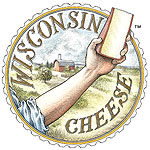 This is an interesting fact – Wisconsin is the only state to offer a Ph.D cheesemaker training program. The training takes three years to complete, and certification is offered in a variety of cheeses. Wisconsin has now graduated 49 cheesemakers from the advanced-level training program, which was established in 1994.
This is an interesting fact – Wisconsin is the only state to offer a Ph.D cheesemaker training program. The training takes three years to complete, and certification is offered in a variety of cheeses. Wisconsin has now graduated 49 cheesemakers from the advanced-level training program, which was established in 1994.
In April, two new members joined the ranks of certified Wisconsin Master Cheesemakers. Paul Reigle, of Maple Leaf Cheese, Monroe, Wis., Yogurt Cheese, and Jerome Zibrowski, of Mindoro, Wis., Blue Cheese and Gorgonzola.
Also included in the 2007 graduating class are returning Masters Terry Lensmire of Trega Foods, Little Chute, and David Lindgren of Lynn Dairy, Granton. Both completed the program a second time for certification in additional varieties. Lensmire, a member of the first graduating class in 1997, previously earned certification in Cheddar and Monterey Jack and is now certified in Provolone and Mozzarella, as well. Lindgren, certified in 2001 in Mozzarella and Provolone, is now also a Master in Cheddar and Monterey Jack.
The Wisconsin Master Cheesemaker® Program is the only Master program in the United States. It is administered by the Wisconsin Center for Dairy Research and funded by Wisconsin dairy producers, through WMMB. Participants must be active, licensed Wisconsin cheesemakers with at least 10 years experience. Cheesemakers can earn certification in up to two cheese varieties each time they enroll and must have been making those varieties as a licensed cheesemaker for a minimum of five years prior to entering the program.

 The fifth annual World Dairy Expo Championship Dairy Product contest will once again be held at World Dairy Expo in October. The contest, sponsored by the
The fifth annual World Dairy Expo Championship Dairy Product contest will once again be held at World Dairy Expo in October. The contest, sponsored by the  The
The  The
The  Here’s the latest announcement from
Here’s the latest announcement from 